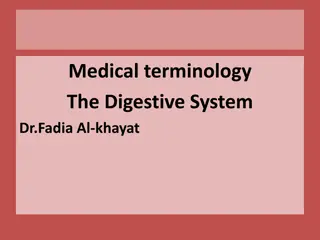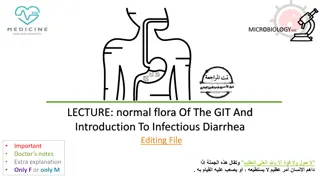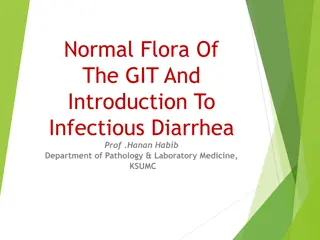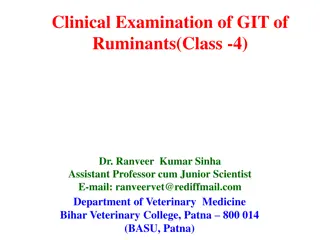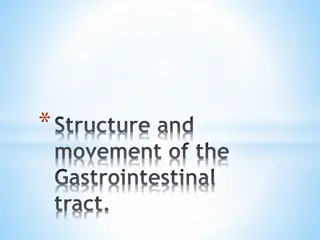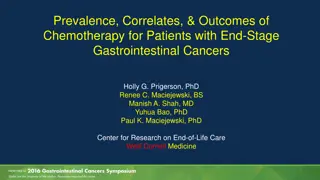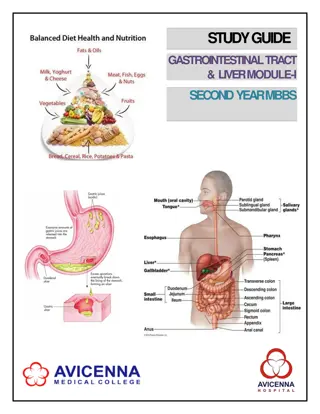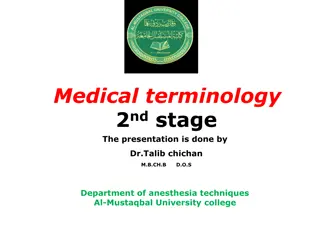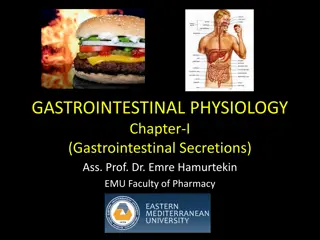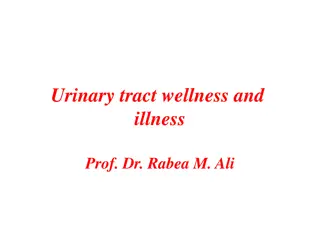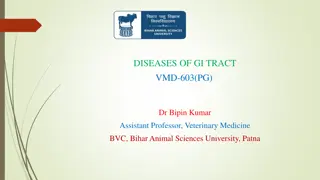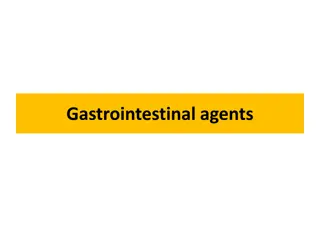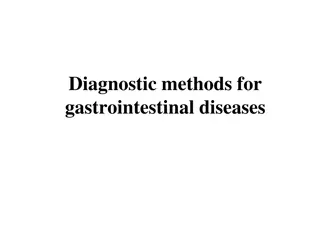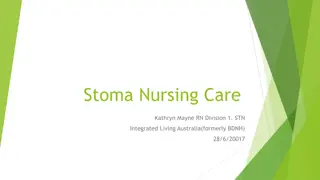Comprehensive Overview of Gastrointestinal Tract Diseases
This detailed guide covers various gastrointestinal tract diseases caused by protozoa and helminths, including amebiasis, giardiasis, pinworm infestation, and trichinosis. It discusses their causes, symptoms, transmission, treatment, and prevention methods. The content provides insights into the life cycles of Entamoeba histolytica and Giardia lamblia, as well as key information on these parasitic infections affecting the human digestive system.
Download Presentation

Please find below an Image/Link to download the presentation.
The content on the website is provided AS IS for your information and personal use only. It may not be sold, licensed, or shared on other websites without obtaining consent from the author. Download presentation by click this link. If you encounter any issues during the download, it is possible that the publisher has removed the file from their server.
E N D
Presentation Transcript
Gastrointestinal Tract Diseases Protozoan and Protozoan and Helminth A. Protozoan Diseases A. Protozoan Diseases 1. 1. Amebiasis Amebiasis a. Caused by Entamoeba histolytica, amoeba: Sarcodina, has two forms: trophozoite and cyst b. Transmitted by ingesting cysts from contaminated water or food c. Type of disease: Causes dysentery, abdominal pain, fever, and diarrhea. Trophozoites attach to walls of large intestine. In some cases can also invade other tissues, especially the liver and lungs. (Travels to these sites by way of peritoneum and diaphragm.) d. Diagnosed by presence of cysts in feces. Some serological tests also available. e. Treated with drugs such as iodoquinol and metronidazole. f. Prevented by proper sanitation, safe drinking water, adequate cooking of food. Helminth Diseases Diseases
2. Giardiasis: 2. Giardiasis: a. Caused by Giardia lamblia, a flagellated protozoan. (both amoebas and Giardia have cyst and trophozoite forms in life cycle) b. Infects the small intestine. Causes diarrhea, abdominal pain, flatulence, and muscular weakness. c. Transmitted by oral/fecal route. By contaminated food or water, by fomites, close contact. Wide host range will contaminate streams and rivers. Sometimes called hikers disease. . cysts are ingested,excysted, trophozoites formed. d. Treated with metronidazole. Prevention: same Giardia - flagellate
B. Helminthes: B. Helminthes: Many important helminthes are transmitted through the gastro-intestinal tract and the infections they give rise to can be classified as in the following table:
1. Pin worm: a. Caused by Enterobius vermicularis, a round worm. (Nematode) b. Common childhood infestation a family affair Causes itching and irritation. c. Spread by eggs (ova). Female lays eggs outside the anus. Itching results in scratching: eggs deposited anywhere hands touch. Ova are ingested; develop into adult male and female worms in intestines. d. Treated with anti-helminthic drugs. Caused by close contact, poor hygiene.
2. Trichinosis: Trichinosis: a. Caused by Trichinella spiralis, a roundworm. b. Transmission: transmitted by eating meat infected with encysted larva. Takes two hosts: Humans are usually infected by eating pork (or bear meat) that has encysted larval forms in muscle tissue. When cyst was eaten, it develops into larvae and adults. c. Type of infection: The adults produce live larvae that migrate in blood to organs and become encapsulated. Damage depends on the tissue affected. d. Prevented by eating non-infected meat, and by proper cooking of meat.
3. Hookworm Hookworm a. a. Necator Necator americanus americanus: : another round worm. b. Human is the host. Causes damage to the walls of the intestines, where adult worms hook on and feed on blood supply. Can cause anemia. Severe intestinal distress. c. Transmitted by live larvae in soil: Life cycle: Ova are transmitted through feces. Ova will develop into larvae in the damp warm soil. The larvae will burrow into skin of human (usually skin between toes, if barefoot), migrate through the circulatory system, eventually coming back to intestines. d. Can be prevented by proper sanitation and protective clothing.
4. Tapeworm: 4. Tapeworm: Have both beef and pork tapeworms. a. Beef: Taenia saginata, Pork: taenia solium. b. Transmitted by eating encysted form (called cysticercus) in improperly cooked meat. Need two hosts: the beef or pigs eat the cysts deposited by from feces of humans. Cysts develop into larvae which encyst in muscle tissue. Humans eat infected meat: cysts develop into larvae and adults. Ova deposited in feces, thus a cylce. c. Cause disease by draining nutrients; can cause intestinal blockage if in large numbers. In case of pork tapeworm, humans can also be infected by ova: causes cystircercus in human tissues.




